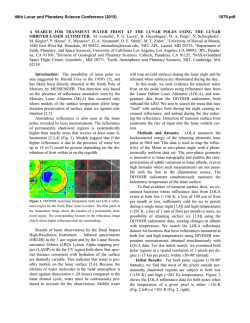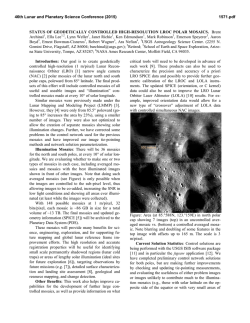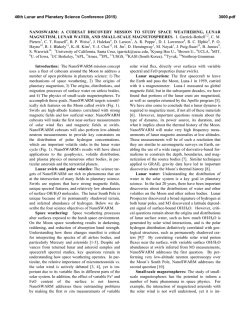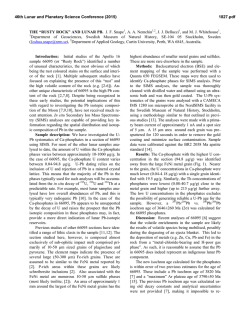
Lunar Phase Function in the Near-Infrared with the Lunar Orbiter
46th Lunar and Planetary Science Conference (2015) 1493.pdf LUNAR PHASE FUNCTION IN THE NEAR-INFRARED WITH THE LUNAR ORBITER LASER ALTIMETER. M. K. Barker1, X. Sun2, E. Mazarico2, G. A. Neumann2, D. E. Smith2,3 and M. T. Zuber3 1Sigma Space Corp., 4600 Forbes Blvd. Lanham, MD 20706 [email protected], 2Solar System Exploration Division, NASA Goddard Space Flight Center 8800 Greenbelt Rd. Greenbelt, MD 20771, 3Dept. of Earth, Atmospheric and Planetary Sciences, MIT, 77 Massachusetts Ave. Cambridge, MA 02139. Introduction: The reflectance of the lunar surface as a function of wavelength and viewing geometry is a fundamental measurement related to the scattering properties of the regolith particles and the structure of the surface [1]. In this study, we report preliminary results on the near-infrared phase function observed with the Lunar Orbiter Laser Altimeter (LOLA) onboard the Lunar Reconnaissance Orbiter. Since December 2013, LOLA has been collecting passive radiometry (reflected sunlight) in the northern hemisphere where the spacecraft altitude is too high for normal altimetric ranging. We describe the passive radiometry calibration, and compare the LOLA nearinfrared phase function to that at shorter wavelengths measured with other instruments. The unique capability of LOLA to also actively measure the normal albedo from the backscattered laser pulse energies during altimetric ranging allows a more complete estimation of the phase function that is difficult to make with typical imagers. Data: LOLA measures surface reflectivity at 1064 nm with two methods: (1) active radiometry and (2) passive radiometry. In method (1), the ratio of the backscattered and transmitted laser pulse energies yields the surface reflectivity at zero phase, called the normal albedo, A n , which is independent of topography. A global 4 pixel-per-degree (ppd) map of the LOLA 1064 nm An was recently produced and analyzed [2]. In method (2), the Sun is the light source and LOLA measures the number of solar photons reflected off the lunar surface. This is quantified by the radiance factor (RADF or I/F), which depends on the photometric angles of incidence, emission, and phase (i, e, and g, respectively) [1]. Since December 2013, LOLA has been collecting passive radiometry in the northern hemisphere where the spacecraft altitude is too high for normal altimetric ranging. In this mode, LOLA acts as a 4-pixel radiometer with pixel size ~60 m, integration time of 1/28th sec (every ~60 m along-track), and signal-to-noise (S/ N) ratio ~50 per pixel in a single “exposure” at low latitudes. To boost the S/N, we use 5-exposure (0.18-sec) moving averages of Channels 2 - 5 (channel 1 does not collect passive radiometry). With this 20point averaging and ~4200 orbits as of November 2014, the total number of data points is ~200 million. The S/N ratio of the averaged data points ranges from ~250 at the equator to ~50 at 75° N. Calibration: We applied temperature-dependent dark current and responsivity corrections to each channel separately. The dark current is modeled as a 3rd order polynomial function of detector temperature. The responsivity correction is a multiplicative scaling of the day side noise counts for each channel after dark subtraction to account for the fact that each channel has slightly different detection thresholds. To calibrate the resulting dark-subtracted counts to absolute radiance values, we used an empirical approach. We matched ~2500 LOLA data points with nearby (< 1 km away) SELENE Spectral Profiler (SP) radiance measurements taken with similar photometric angles (Δi, Δe, Δg < 10°). The SP radiance in the 1060 and 1068 nm channels were interpolated to 1064 nm. Figure 1 shows a plot of the matched points and resulting calibration. The error bars include spectral and spatial variation due to surface heterogeneity in the SP and LOLA data as well as shot noise in the LOLA data. Further work will investigate a theoretically-motivated calibration using knowledge of the detector properties and probability distribution of noise counts [3]. Results: Figure 2 shows the phase function for highlands and maria separately after dividing the RADF by a Lommel-Seeliger limb-darkening law Figure 1 - Radiance calibration of LOLA passive radiometry. Roughly 2500 LOLA data points were matched with nearby SELENE SP radiance measurements taken under similar viewing geometries. 46th Lunar and Planetary Science Conference (2015) (a) 1493.pdf (b) Figure 2 - LOLA 1064 nm phase function: Shaded regions show the central 68% interval for highlands (orange) and maria (gray). Phase functions from the literature for (a) highlands and (b) maria are overplotted as lines and normalized at g = 30°. Dashed black: Clementine 950 nm [5], solid red: LROC WAC 689 nm [4], solid green: SP 1068 nm [7], dashed blue: Chandrayaan-1 M3 1070 nm [8]. using the LOLA 128 ppd global elevation model to radiometry (lower panel). For the latter, we computed a derive the topography-dependent photometric angles. lookup table of mean RADF of all passive The RADF was also divided by the spatially resolved measurements in 1-degree bins of (i, e, g) and divided 1064 nm An map [2] to correct for surface reflectivity each individual measurement by the lookup table value variation. The maria phase function is lower than the for its corresponding bin. The RMS residual between highlands, possibly due to a smaller contribution from the two maps’ pixels is ~10%, the median residual is backscattering. This would be consistent with the ~-2%, and the median absolute residual is ~5%. behavior at UV-visual wavelengths observed with the Future work will explore more quantitatively what Lunar Reconnaissance Orbiter Camera (LROC) [4]. constraints can be placed on the parameters of Several phase functions from the literature are also physically-motivated phase function models, elucidatoverplotted in Fig. 2 for the case of i = g and e = 0°, ing the wavelength dependence of the phase function, which approximates the geometries for the majority of for which our theoretical understanding is presently LOLA observations. The functions are arbitrarily norincomplete [6]. malized to the same value at g = 30° for the (a) highReferences: [1] Hapke, B. Theory of Refl. and lands and (b) maria separately. Inspection of Fig. 2 Emitt. Spect. (2012), 2nd ed., Camb. U. Pr. [2] Lucey, shows that the Clementine 950 nm phase function [5] P. et al. (2014) JGR Planets, 119, 1665. [3] Sun, X. et and LROC WAC 689 nm phase function [4] provide al. (2006) Applied Optics, 45, 3960. [4] Sato, H. et al. similarly reasonable fits for the highlands. However, (2014) JGR Planets, 119, 1775. [5] Shkuratov, Yu. G. they underestimate and overestimate, respectively, the et al. (1999) Icarus, 141, 132. [6] Hapke, B. et al. opposition surge for the maria. This may be because (2012) JGRE, 117. [7] Yokota et al. (2011) Icarus, 215, the Clementine function was derived only for the high639. [8] Besse, S. et al. (2013) Icarus, 222, 229. lands and the LROC function, while derived for the maria and highlands separately (see Fig. 17 of [4]), applies to 689 nm. This also is consistent with previous results that the opposition surge angular width has little wavelength dependence for the highlands [6], but some wavelength dependence for the maria [4]. The SP 1068 nm phase function [7], derived for the maria and highlands separately, underestimates the opposition surge for the highlands, but provides the best fit for the maria. The shape of the Chandrayaan-1 M3 1070 nm phase function [8], derived only for the highlands, does Figure 3 - Upper panel: 4 ppd map of 1064 nm not match the LOLA data or the other functions. normal albedo (An) from active radiometry [2]. Figure 3 shows the 4 ppd map of 1064 nm An from Lower panel: An from passive radiometry. The active radiometry [2] (upper panel) and from passive grayscale ranges from 0.1 (black) to 0.4 (white).
© Copyright 2025






